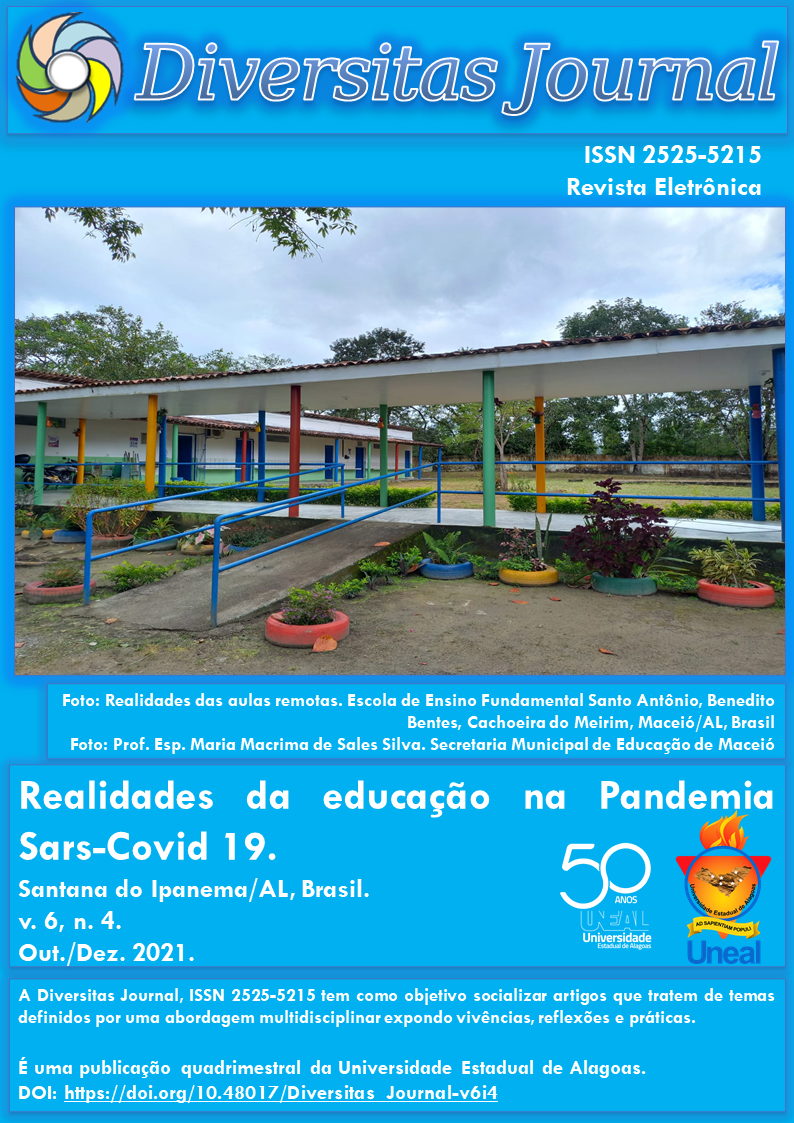Visual Mathematics for the Development of Mathematical Mentalities in Students of a Public School.
DOI:
https://doi.org/10.48017/dj.v6i4.1966Abstract
The present research aimed to develop numerical sense, through the use of visual mathematics, based on the Theories of Mathematical Mentalities in 9th grade students of elementary school II of a municipal school in the city of Junqueiro - AL. Recent studies in neuroscience show that we are all capable of learning math at a high level as long as we are properly stimulated. It is quite common to see students from elementary school to higher education stating that they do not like math, well, the reason for this contempt in math, most of the time, is due to the way the contents are taught, causing many students to lose interest in that area. However, there are other methods of teaching mathematics and one of them is the use of visual mathematics. Several studies show that working with visual mathematics makes the student gain self-confidence, well, the purpose of this work is to show that visual mathematics can lead the student to understand the teaching of mathematics in a clearer way. In the course of this work, we will understand, through a research with a mixed focus, how content approaches through visual mathematics can interfere with cognitive development and learning in mathematics in students at a public school in the interior of Alagoas. We will discuss concepts and present the result of a case study, based on ideas present in the book by British author Jo Boaler, observing how this methodology can be transformative. Analyzing the survey data, we conclude that visual mathematics really facilitated students' learning, as well as changing their relationship with mathematics.
Metrics
References
Berch D. Making sense of number sense: implications for children with mathematical disabilities. J Learn Disabil. 2005;38(4):333-9.
BICUDO, M. A. V. (org.) Educação matemática. São Paulo: Moraes, 1985.
BITTAR, M. A abordagem instrumental para o estudo da integração da tecnologia na prática pedagógica do professor de matemática. Educar em Revista, Curitiba, Brasil, n. Especial 1/2011, p. 157-171, 2011. Editora UFPR
BRASIL. Ministério da Educação. Base Nacional Comum Curricular. Brasília, 2018.
BOALER, Jo. Metalidades Matemáticas: estimulando o potencial dos estudantes por meio da matemática criativa, das mensagens inspiradoras e do ensino inovador. Tradução de Daniel Bueno. Porto Alegre: Penso, 2018.
BOALER, JO et al (2016) Seeing as Understanding: The Importance of Visual
Mathematics for our Brain and Learning. J Appl Computat Math 5: 325. doi: 10.4172/2168-9679.1000325.
Boaler, J. & Zoido, P. (in press). The Impact of Mathematics Learning Strategies upon Achievement: A Close Analysis of Pisa Data.
BECKER, Fernando. Epistemologia do Professor de Matemática. Petrópolis: Vozes, 2012.
CORSO, L. V. & DORNELLES, B. V. Rev. Psicopedagogia 2010; 27(83): 298-309
Cosenza, R. M., & Guerra, L. B. (2011). Neurociência e educação: como o cérebro aprende. Porto Alegre: Artmed.
D’ AMBROZIO, Ubiratan. Da realidade a ação: Reflexões sobre a educação e matemática. Campinas: Unicamp, 1996.
D’AMBRÓSIO, U. A História da Matemática: questões historiográficas e políticas e reflexos na Educação Matemática. In: BICUDO, M. A. V. (org.). Pesquisa em Educação Matemática: concepções e perspectivas. São Paulo: UNESP, 1999, p. 97-115.
Doneda de Oliveira, V. S., & Basniak, M. I. (2021). FRAÇÕES E SUAS MÚLTIPLAS INTERPRETAÇÕES: reflexões sobre o ensino e a aprendizagem. Revista De História Da Educação Matemática, 7, 1-20. Recuperado de <http://www.histemat.com.br/index.php/HISTEMAT/article/view/388> em 20/08/2021.
Feikes, D. & Schwingendorf, K. (2008). The Importance of Compression in Children’s Learning of Mathematics and Teacher’s Learning to Teach Mathematics. Mediterranean Journal for Research in Mathematics Education 7 (2).
FERRARI, A. H. O Senso Numérico na Criança: Formação e Características. Doutorado em Educação Matemática. PUC-SP. São Paulo, 2008
FREIRE, Paulo. Pedagogia da autonomia: Saberes necessário a pratica educativa. São Paulo: Paz e Terra, 1996.
MENON, V. Arithmetic in child and adult brain. In: Handbook of mathematical cognition, K. R. Cohen & A. Dowker (orgs.). Oxford University Press, 2014.
PARRA, C; SAIZ, I. (org.). Didática da matemática: reflexões psicopedagógicas. Porto Alegre: Artes médicas, 1996.
RAMOS, Daniela Karine; LORENSET, Caroline Chioquetta; PETRI, Giani. JOGOS EDUCACIONAIS: CONTRIBUIÇÕES DA NEUROCIÊNCIA À APRENDIZAGEM. Revista X, [S.l.], v. 2, n. 1.2016, nov. 2016. ISSN 1980-0614. Disponível em: <https://revistas.ufpr.br/revistax/article/view/46530/29523>. Acesso em: 05 set. 2021. doi:http://dx.doi.org/10.5380/rvx.v2i1.2016.46530.
REVISTA EDUCAÇÃO. Conceito “Mentalidades Matemáticas” desfaz mitos com base na neurociência. Disponível em: https://www.revistaeducacao.com.br/mentalidades-matematicas/ . Acesso em: 24 de maio de 2019.
Sampieri, R.H., Collado, C.F., & Lucio, M. B. (2013). Metodologia de Pesquisa (5ª ed.). Porto Alegre: Penso.
Temple, C. (1997). Developmental cognitive neurpsychology. Hove (UK): Psychology Press.
Downloads
Published
How to Cite
Issue
Section
License
Copyright (c) 2021 Fabrício de Oliveira Lima, Daniel Nicolau Brandão, Douglas Muller da Silva, Leonardo Rodrigues de Btito, Weverton Barros Vieira

This work is licensed under a Creative Commons Attribution 4.0 International License.
The Diversitas Journal expresses that the articles are the sole responsibility of the Authors, who are familiar with Brazilian and international legislation.
Articles are peer-reviewed and care should be taken to warn of the possible incidence of plagiarism. However, plagiarism is an indisputable action by the authors.
The violation of copyright is a crime, provided for in article 184 of the Brazilian Penal Code: “Art. 184 Violating copyright and related rights: Penalty - detention, from 3 (three) months to 1 (one) year, or fine. § 1 If the violation consists of total or partial reproduction, for the purpose of direct or indirect profit, by any means or process, of intellectual work, interpretation, performance or phonogram, without the express authorization of the author, the performer, the producer , as the case may be, or whoever represents them: Penalty - imprisonment, from 2 (two) to 4 (four) years, and a fine. ”


















